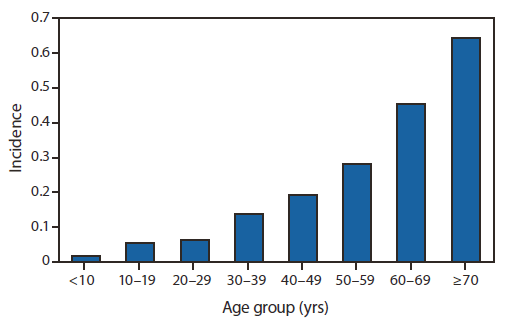# 5738
Arboviruses belong to a large group of viruses carried and transmitted by biting mosquitoes, ticks, and other arthropods when they take a blood meal from susceptible vertebrate hosts.
The map below shows the global distribution of some of the more common encephalitis producing arboviruses.
A few of my blogs from last year on these viral threats included:
EEE Reports In Michigan And R.I.
Florida Records 4th EEE Death In July
ASTMH: Dengue and Insect-Borne EIDs In The US
Eastern Equine Encephalitis (EEE)
This week the CDC’s MMWR contains a surveillance report on arthropod-borne viruses – or arboviral - infections (excluding Dengue which is tracked separately) in the United States during 2010.
And last year, it turns out, was a banner year for arboviral disease in the United States, with the number of West Nile Virus (WNV) cases (1,021) up sharply over 2009, and 62% of those producing neuroinvasive disease (i.e., meningitis, encephalitis, or acute flaccid paralysis).
Other viral players included California serogroup viruses (CALV), eastern equine encephalitis virus (EEEV), St. Louis encephalitis virus (SLEV) and Powassan virus (POWV).
A few excerpts from the report follow (slightly reformatted for readability). Follow the link to read it in its entirety.
West Nile Virus Disease and Other Arboviral Diseases --- United States, 2010
Weekly
August 5, 2011 / 60(30);1009-1013Arthropod-borne viruses (arboviruses) are transmitted to humans primarily through the bites of infected mosquitoes and ticks. Since West Nile virus (WNV) was first detected in the Western Hemisphere in 1999, it has become the leading cause of neuroinvasive arboviral disease in the United States (1).
However, several other arboviruses continue to cause sporadic cases and seasonal outbreaks of neuroinvasive disease (i.e., meningitis, encephalitis, or acute flaccid paralysis) (1,2).
This report summarizes surveillance data reported to CDC in 2010 for WNV and other nationally notifiable arboviruses (excluding dengue, which is reported separately).
In 2010, 40 states and the District of Columbia (DC) reported 1,021 cases of WNV disease. Of these, 629 (62%) were classified as WNV neuroinvasive disease, for a national incidence of 0.20 per 100,000 population. States with the highest incidence were Arizona (1.60), New Mexico (1.03), Nebraska (0.55), and Colorado (0.51).
After WNV, the next most commonly reported cause of neuroinvasive arboviral disease was California serogroup viruses (CALV), with 68 cases, followed by eastern equine encephalitis virus (EEEV), 10 cases, St. Louis encephalitis virus (SLEV), eight cases, and Powassan virus (POWV), eight cases. WNV and other arboviruses continue to cause focal outbreaks and severe illness in substantial numbers of persons in the United States. Maintaining surveillance remains important to guide arboviral disease prevention activities.
Given the limitations of surveillance, and the fact that many people experience mild, or non-specific symptoms of infection, the true burden of these (mostly) mosquito borne viruses in the United States can only be estimated.
The editorial note to this report states:
Detection and reporting are incomplete, leading to a substantial underestimate of the actual number of cases. Based on previous studies, for every case of WNV neuroinvasive disease, approximately 140 human WNV infections occur, with 80% of infected persons remaining asymptomatic and 20% developing nonneuroinvasive disease (7,8).
Extrapolating from the 629 reported WNV neuroinvasive disease cases, an estimated 88,000 infections and 17,600 cases of nonneuroinvasive disease might have occurred in 2010; however, only 392 (2%) nonneuroinvasive disease cases were reported.
As the chart below indicates, the older adults are more apt to develop neuroinvasive disease from a WNV infection.
FIGURE. Incidence* of cases (N = 629) of West Nile virus neuroinvasive disease,† by age group --- United States, 2010
* Per 100,000 population, based on July 1, 2010, U.S. Census estimates.
† Meningitis, encephalitis, or acute flaccid paralysis.
A summation of the report reads:
What is already known on this topic?
Since West Nile virus (WNV) was first detected in the Western Hemisphere in 1999, it has become the leading cause of neuroinvasive arboviral disease in the United States. However, several other arboviruses can cause sporadic cases and seasonal outbreaks of neuroinvasive disease.
What is added by this report?
WNV was the most common cause of neuroinvasive arboviral diseases in the United States in 2010; however, La Crosse virus was the most common cause among children. Eastern equine encephalitis, although rare, remained the most severe arboviral disease, with a 50% case-fatality rate.
What are the implications for public health practice?
WNV and other arboviruses continue to be a source of severe illness each year for substantial numbers of persons in the United States. Maintaining surveillance remains important to help direct and promote prevention activities.
While the odds of contracting a serious illness from mosquito bites in the United States remains very low - if you visit or live in mosquito territory – it is worth remembering Florida Department of Health’s, (FDOH)
recommendation that individuals protect themselves by following the “5 D’s”.
Related Post:
Widget by [ Iptek-4u ]


